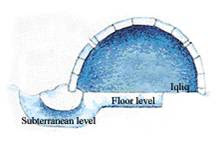
A tunnel is made accessible to the inside of an igloo and must be lower than the floor level. This is because the cold air that enters the tunnel will stay in the tunnel and will not be able to enter the igloo as cold air sinks and hot air rises. Sometimes, the tunnel entrance may be accessed by a subterranean channel or by an angled tunnel. The opening however is ensured to be small to reduce the possibility of cold air from entering once the snow block or bear-skin door is opened.
To keep warm, some Inuit groups line the inside of the igloo with caribou hides for better heat insulation. With the addition of blubber lamps, bodyheat and a stove for making tea, the internal temperature of an igloo can hit 15.5°C or more even though the outside temperature may be -40°C.

Paul Oliver
In order to avoid the cold, the Inuit family will sit on the iqliq with their backs to the wall and legs extended but not overhanging. This platform will also be covered with moss and sealskins or hides to ensure warmth.
Contributed by Kim Casey
Reference: Paul Oliver, "Dwellings", Phaidon Press, 2003
4 comments:
Hello Mazlin,
Are the poles inside support poles for the walls? I see two that look like maybe support columns.
Does the igloo ever melt from the inside out or do they keep adding ice or snow?
What is the life span of an igloo? Under normal conditions.
I think these igloo post are great, just one more reason for round homes. :)
Kyle
The poles inside are not support poles but perhaps Inuit equipment as an igloo does not need any additional support because nature has it that the snow which turns to ice will help in the strength of the structure.
The igloo does melt inside because of the body temperature and cooking heat from the stoves. Once the gaps on the igloo are covered with snow, it is not necessary to add any more ice or snow.
Snow and ice would probably melt under warm temperatures so they'd probably last till the end of winter. By that time, the Inuits would not need to live in igloos and would stay in tents.
Try one of the ICE HOTEL accommodation. http://www.icehotel.com/Summer/Home/
FADZLAN
http://jalakmas.blogspot.com/
Nice blog. The article you have shared is good.This article is very useful. My friend suggest me to use this blog. I am working at essay writing service reviews. Thank you for sharing.
Post a Comment